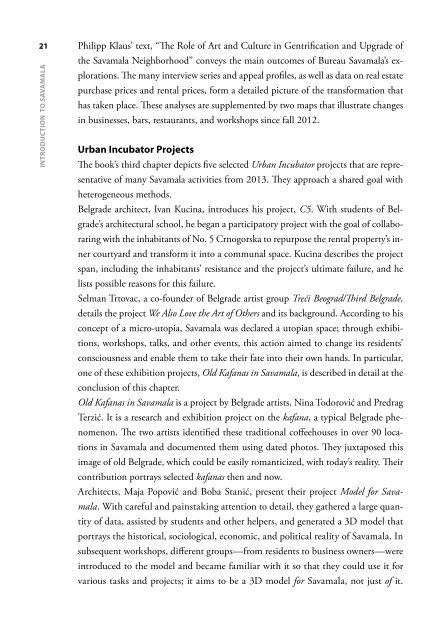Bureau Savamala Belgrade
978-3-86859-359-4
978-3-86859-359-4
You also want an ePaper? Increase the reach of your titles
YUMPU automatically turns print PDFs into web optimized ePapers that Google loves.
21<br />
Introduction to <strong>Savamala</strong><br />
Philipp Klaus’ text, “The Role of Art and Culture in Gentrification and Upgrade of<br />
the <strong>Savamala</strong> Neighborhood” conveys the main outcomes of <strong>Bureau</strong> <strong>Savamala</strong>’s explorations.<br />
The many interview series and appeal profiles, as well as data on real estate<br />
purchase prices and rental prices, form a detailed picture of the transformation that<br />
has taken place. These analyses are supplemented by two maps that illustrate changes<br />
in businesses, bars, restaurants, and workshops since fall 2012.<br />
Urban Incubator Projects<br />
The book’s third chapter depicts five selected Urban Incubator projects that are representative<br />
of many <strong>Savamala</strong> activities from 2013. They approach a shared goal with<br />
heterogeneous methods.<br />
<strong>Belgrade</strong> architect, Ivan Kucina, introduces his project, C5. With students of <strong>Belgrade</strong>’s<br />
architectural school, he began a participatory project with the goal of collaborating<br />
with the inhabitants of No. 5 Crnogorska to repurpose the rental property’s inner<br />
courtyard and transform it into a communal space. Kucina describes the project<br />
span, including the inhabitants’ resistance and the project’s ultimate failure, and he<br />
lists possible reasons for this failure.<br />
Selman Trtovac, a co-founder of <strong>Belgrade</strong> artist group Treći Beograd/Third <strong>Belgrade</strong>,<br />
details the project We Also Love the Art of Others and its background. According to his<br />
concept of a micro-utopia, <strong>Savamala</strong> was declared a utopian space; through exhibitions,<br />
workshops, talks, and other events, this action aimed to change its residents’<br />
consciousness and enable them to take their fate into their own hands. In particular,<br />
one of these exhibition projects, Old Kafanas in <strong>Savamala</strong>, is described in detail at the<br />
conclusion of this chapter.<br />
Old Kafanas in <strong>Savamala</strong> is a project by <strong>Belgrade</strong> artists, Nina Todorović and Predrag<br />
Terzić. It is a research and exhibition project on the kafana, a typical <strong>Belgrade</strong> phenomenon.<br />
The two artists identified these traditional coffeehouses in over 90 locations<br />
in <strong>Savamala</strong> and documented them using dated photos. They juxtaposed this<br />
image of old <strong>Belgrade</strong>, which could be easily romanticized, with today’s reality. Their<br />
contribution portrays selected kafanas then and now.<br />
Architects, Maja Popović and Boba Stanić, present their project Model for <strong>Savamala</strong>.<br />
With careful and painstaking attention to detail, they gathered a large quantity<br />
of data, assisted by students and other helpers, and generated a 3D model that<br />
portrays the historical, sociological, economic, and political reality of <strong>Savamala</strong>. In<br />
subsequent workshops, different groups—from residents to business owners—were<br />
introduced to the model and became familiar with it so that they could use it for<br />
various tasks and projects; it aims to be a 3D model for <strong>Savamala</strong>, not just of it.


















